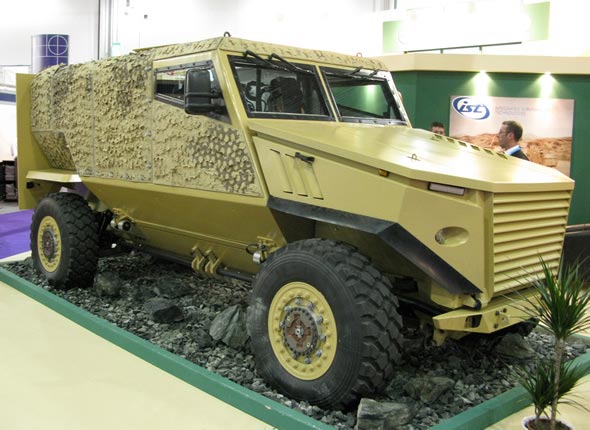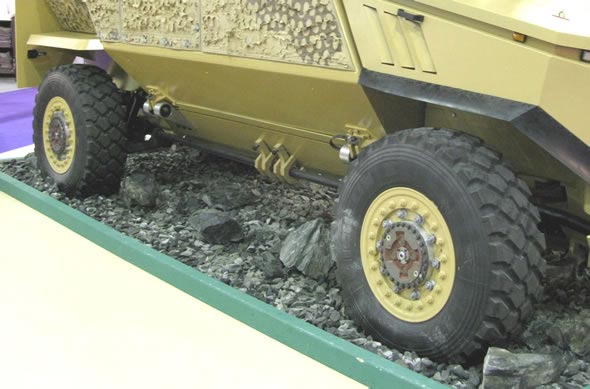Force Protection Europe (FPE) and Ricardo, Inc., the US subsidiary of racing specialist Ricardo plc, have teamed to develop a compact and versatile light armored, mine-protected vehicle designed for off-road operations. The vehicle dubbed ‘Ocelot’, was launched at a unique collaboration between Ricardo and Force Protection Europe. The Ocelot addresses the new category of Light Protected Patrol Vehicle (LPPV) concept, by offering high levels of protection, mobility and configuration versatility. FPE is the UK subsidiary of Force Protection International, the manufacturer of the Cougar Mine Resistant Ambush Protected (MRAP) vehicle, and its Mastiff and Ridgeback derivatives operated by the UK.


According to David Hind, Managing Director of FPE, “designing from a clean sheet we have adopted a novel design which is a complete departure from the standard practice of basing mine resistant vehicles on a standard chassis design. We are confident that the V-shape design of Ocelot, not only meets today’s blast resistance requirements, but those expected in the future.” This approach enabled the team to integrate the latest innovations in automotive and defense technologies to deliver a practical and versatile platform.
The vehicle is based on a modular design, comprising a core automotive armored spine or “skateboard”, onto which one of a number of alternative special to role “pods” is mounted. These roles include a patrol, fire support or protected logistics vehicle, sharing the common and interchangeable core. This concept enables the unit operating Ocelots to maintain mission capable forces, while addressing maintenance schedules or combat attrition, by reconfiguring available vehicles with the pods needed for each mission, rather than stocking spare vehicles as a reserve fleet. Vehicle pods are easily interchangeable in the field as the need requires.

The V-shaped hull configuration formed by the combination of skateboard and an armor protected pod provides a practical vehicle package with good maneuverability, operational flexibility and high levels of protection for the crew. The vehicle has integral ballistic and mine protection, while EFP and RPG protection necessitates additional appliqué armor kits. The skateboard spine also provides added protection to the internal automotive systems, improving operational robustness.
The Ocelot uses independent lockable differentials axles and a powerful diesel engine, delivering high power-to-weight ratio (up to 25 kw/ton in combat mode) enhancing off-road mobility. This capability is further supported by the ground clearance of 0.338 meters, and 3.65 m wheelbase. The vehicle can climb a gradient of 60 degrees, tilt over 33 degrees angle and travel at a top speed of 110 km/h, accelerating to 80 km/h in 19.75 seconds. The fuel autonomy supports over 600 km of travel distance. Ocelot utilizes the four wheel steering Ocelot can turn in less than 12 m circle.
Designed to meet the British requirement for LPPV the Ocelot is designed for a gross vehicle weight of 7.5 tons, carrying a payload 2 tons. The patrol version accommodates six soldiers (2+4), the weapon carrier WMIK version (Weapon Mounted Installation Kit) carries 2+2 while the logistical variant seats a crew of two.
Ricardo’s Skateboard & Pod Bring Racing Experience to the Battlezone
The Ocelot’s V-shaped hull that mounts p[art of the belly protection and all the automotive systems except the torsion bars. It houses the Steyr 3.2 litre straight six diesel powerpack, propshaft, 6-speed ZF gearbox, AxelTech differentials, fuel tank and all the suspension gear. The V-shape design results in the running gear not intruding into the crew area making movement from front to back easy and also reducing the threat to the occupants from the running gear in the event of an attack. The torsion bar is mounted alongside the hull; in the event of an attack the vehicle is able to keep moving even if it has lost a wheel as the rest of the automotive parts are protected.
The composite pod has been designed to be interchangeable, and in the patrol vehicle there is seating for two crew and four dismounts. Access to the vehicle is through large rear doors, two top hatches or if required an oversize commander’s door. Bulkheads between the cabin and passenger compartment and between them and the vehicle electronic equipment (radios and electronic counter measures) give added protection. The pod uses a novel tilting mechanism attaching to the hull by hinges which are kept in place with pins. To carryout maintenance the wiring loom from the pod is disconnected from the skateboard together with the steering connection and the crew pod is then tilted using an another vehicle and strops to pull it over, providing full access to all automotive parts. To change the pod the pins are removed from the pod and the skateboard driven to a new pod and this is then connected and tilted back onto the vehicle. As part of the design of the vehicle maintenance was a high priority and integral to the overall concept enabling major assemblies to be rapidly changed in the field rather than having to recover the vehicle to a base workshop to carry out repairs. For example a new powerpack can be flown into a forward operating base and changed over in less than one hour.
Prospects in Australia, USA
Force protection is considering the Ocelot as the pioneer for a family of light – to medium off-road protected vehicles ranging from 4×4 7.5 to 6×6 10 tons gross vehicle weight (GVW). The can carry a 1.5-tonne payload and has a modular configurable protected pod that can be designed as a flatbed, load carrier, weapon carrier; troop carrier; ambulance or open-top vehicle.
In addition to the British LPPV competition, Ocelot has also been offered for the Australian Land 121 Project Overlander program. In addition, Force Protection hasn’t given up on the U.S. opportunities, and is waiting for the USMC decision on a potential alternative to some of the corps’ Joint Light Tactical Vehicles, following the completion of testing of the three versions being evaluated by the joint Army-USMC team.
Further reading:
Innovative Designs Pursue new Opportunities for Light Patrol Vehicle



















